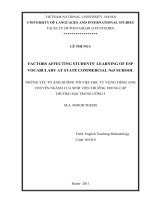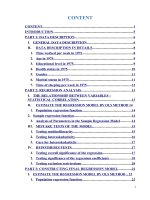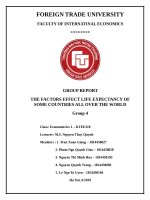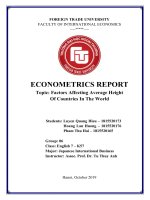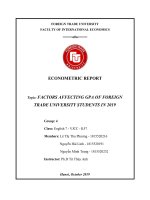Tiểu luận tiếng anh Kinh tế chuyển nhượng the factors affecting monthly expenditure of FTU's studen.doc
Bạn đang xem bản rút gọn của tài liệu. Xem và tải ngay bản đầy đủ của tài liệu tại đây (196.57 KB, 30 trang )
Econometrics Assignment
TABLE OF CONTENTS
Page
I. INTRODUCTION...........................................................................................1
II. METHODOLOGY........................................................................................2
1. DEFINITION..............................................................................................2
1.1. Income................................................................................................2
1.2. Expenditure.........................................................................................3
2. THEORIES OF CONSUMERS’ BEHAVIOR.............................................3
3. THE KEYNESIAN CONSUMPTION FUNCTION....................................5
III. ECONOMETRIC MODEL.........................................................................7
1. MODEL CONSTRUCTION........................................................................7
2. COEFFICIENTS PREDICTION..................................................................8
IV. DATA DESCRIPTION................................................................................9
V. EMPERICAL RESULTS............................................................................13
1. USING THE ABOVE DATA TO ESTIMATE
THE REGRESSION MODEL BY OLS METHOD.......................................13
2. MEANING OF THE REGRESSION COEFFICIENTS.............................14
3. TESTING THE SIGNIFICANCE OF THE
REGRESSION COEFFICIENTS AND THE
RELEVANCE OF THE REGRESSION FUNCTION....................................14
4. FIRST CURE: FOR THE REGRESSION MODEL...................................17
5. TESTING THE CONFORMITY WITH
THE ASSUMPTIONS OF OLS METHOD...................................................21
6. SECOND CURE: FOR THE HETEROSKEDASTICITY..........................23
7. FINAL REGRESSION MODEL................................................................28
VI. CONCLUSION...........................................................................................29
VII. REFERENCES.........................................................................................30
- 1 -
Econometrics Assignment
I. INTRODUCTION
Vietnam in recent years, along with nearly 200 countries around the world, has
been integrating into the trend of globalization and exercising national campaigns
towards the overall development in economic, political, social and cultural aspects.
In this context, human capital is considered one of the key factors for Vietnam’s
long-term revolution, and it is university students that make up an indispensable part
in the domestic labor force in the future.
Regarded as one of the most privileged universities in Vietnam, Hanoi Foreign
Trade University has long attracted thousands of students from North to South every
year. Each student, as a matter of fact, has his own family background, distinctive
personalities as well as certain level of knowledge and experience. Such factors,
certainly, have significant impacts on students’ daily life, in which students’
expenditure should be mentioned first of all.
Therefore, after taking everything into consideration, we decided to choose and
study the project: “THE FACTORS AFFECTING MONTHLY EXPENDITURE
OF FTU’S STUDENT”. Although the government has tried to implement financial
aid programs for university learners, we, especially those coming from provincial
areas, have still met many difficulties in managing our spending every day. It is
really not easy to allocate our limited source of money into a range of activities in
the most effective way. Thus through our project, we would like to provide you with
more in-depth understanding about some main factors dominating daily spending of
FTU’s students. We hope that arguments and statistics in this project will be helpful
for you in drawing a reasonable plan of expenditure for the time being.
- 2 -
Econometrics Assignment
II. METHODOLOGY
In this project, we consider three factors that may affect students’ monthly
spending: income, students’ homeland and students’ characteristics.
Homeland and characteristics are two qualitative variables. In general they have
certain impacts on the ways students plan their expenditure. For instance, a student
coming from rural area may consume less than one coming from a big city.
Similarly, the amount of spending depends on whether the student is generous or
thrifty, shopping-lover or shopping-averse.
Income, by contrast, is a quantitative variable. It can be said that income and
expenditure are two critical elements of the market economy, as everyone has to
consider how to spend their disposable income in the most reasonable way. There
also exists a close-knit relationship between those two factors, thus we will use
microeconomic and macroeconomic theories and models to interpret it.
1. DEFINITIONS
1.1. Income
There are two main types of income, which can be listed as personal income and
disposable income.
1.1.1. Personal income (PI)
Personal income is the income earned by households and non-corporate
businesses. Unlike national income, it excludes retained earnings, which is the
amount of revenue corporations have earned but have not paid out to stockholders as
dividend. It also subtracts corporate income taxes and contributions for social
insurance (mostly Social Security taxes). In addition, personal income includes
interest income, the amount households receive from their holdings of government
debt, and transfer payment, the amount they get form government transfer program
such as welfare and social security.
- 3 -
Econometrics Assignment
1.1.2. Disposable income (DI)
Disposable personal income is the net income that households and non-corporate
businesses earn after fulfilling all their obligations to the government. It equals
personal income minus personal taxes and certain non-tax payments (such as traffic
tickets).
DI = PI – personal taxes
In the scope of our project, however, our studied subjects are FTU’s students
who have no obligation to pay income tax. Thus they have entire disposal of what
they earn, which means that their personal income also equals their disposable
income. Besides, students’ earnings generally come from two main sources: family
financial support and income from part-time jobs. Family financial support is the
monthly amount supported by students’ families so that they can fulfill their daily
life. Income from part-time jobs is what students earn when participating in the
labor market, which is tax-free.
1.2. Expenditure
Expenditure is the sum of money each individual uses for the purchase of goods
and services to satisfy their needs.
For instance, each month students have to pay for some urgent needs such as
food, clothing, traveling fees, housing expenses (if students have to rent a
house), and so on. Those all aim at responding to personal needs of students.
2. THEORIES OF CONSUMERS’ BEHAVIOR
• We assume that university students always try to maximize their own utility
by using a number of certain resources. This means that although there are
many ways of planning expenditure, students will only follow the choice that
is most likely to optimize their satisfaction. Moreover, as there always exists
- 4 -
Econometrics Assignment
a limit to students’ income, they have to consider how to allocate that
restricted source for a variety of daily activities.
In short, this part of our project has two main objectives. The first one is to study
how students use their income to bring about maximum benefit for themselves. And
the second one is to explain how income affects expenditure theoretically and
realistically.
• The theories of consumers’ behavior, in microeconomics, begin with three
basic assumptions about consumers’ preference.
Firstly, preferences are complete. This means that consumers can rank their
baskets of goods based on personal preferences or different levels of utility they
may provide. Prices of goods have no effects on consumers’ choice in this case.
Secondly, preferences are transitive. If a person prefers good A to good B, and
good B to good C, certainly he will prefer good A to good C.
Thirdly, in case of normal goods, consumers always prefer more to less. This is
an obvious argument, because everyone feels more satisfied when consuming more
goods and services.
• Generally our project still relies on those basic assumptions, but instead of
goods, we aim to study different ways of planning expenditure of FTU’s
students. Thus in the scope of this project, we will adjust the three
assumptions as follows.
Firstly, students can compare and rank different choices of spending based on
their satisfaction.
Secondly, of a student prefers choice A to choice B, and choice B to choice C,
this means that he prefers choice A to choice C.
Thirdly, students will choose the choice of expenditure that benefits them most.
- 5 -
Econometrics Assignment
3. THE KEYNESIAN CONSUMPTION FUNCTION
In general, the basic form of consumption function is as follows:
C = f(Yd)
with Yd representing disposable income. But as afore-mentioned, since there is
no personal income tax levied on university students, their disposable income also
equals their personal income. In this case, the consumption function can be rewritten
as :
C = f(Y)
This reflects the relationship between planned expenditure and disposable
income.
Generally students’ spending increases when income increases, but it is assumed
to rise less quickly than income. The reason is that students tend to divide their
earnings into two parts: consumption and savings. This means that they do not
spend all their money on the purchase of goods and services but tend to save a small
amount to deal with unexpected incidents in the future, such as illnesses, burglaries,
house-moving, etc. This is a popular psychological phenomenon of almost every
student in Vietnam, especially those coming from provincial areas to big cities to
further their study.
If consumption rises at a lower speed than income does, the ratio
consumption/income will decrease as income increases. We use a linear function in
the form of y = a + bx to build the consumption function.
In particular, we have the standard Keynesian consumption function as follows:
1
( ) .C f Y C MPC Y= = +
where C = Students’ expenditure
- 6 -
Econometrics Assignment
C
= Autonomous consumption. This is the level of
consumption that will take place even if income is zero. If an
individual's income falls to zero, some of his existing spending
can be sustained by using savings. This is known as dis-saving
spending.
MPC = Marginal propensity to consume. This is the change
in consumption divided by the change in income, or in other
words, it determines the slope of the consumption function.
The MPC reflects the effect of an additional VND of
disposable income on consumption.
C
MPC
Y
∆
=
∆
As you can see from the graph above, we always have: 0 < MPC < 1. If MPC
equals to 1, this means that students’ spending always equals students’ income,
which is irrational in reality. Actually when a student’s income reaches a certain
level, he will not spend all the money but keep a certain amount as savings.
Certainly, savings will increase as income increases, thus MPC can never equal to 1.
- 7 -
Econometrics Assignment
In conclusion, there is a positive relationship between disposable income (Yd)
and students’ spending (C). The gradient of the consumption curve gives the
marginal propensity to consume. The intercept gives the autonomous consumption,
which exists even if students have no current disposable income.
III. ECONOMETRIC MODEL
1. MODEL CONSTRUCTION
a) Variables:
- Dependent variable:
EXP: Student’s monthly expenditure (unit: thousand dong)
- Independent variables:
+ CHA (dummy): Student’s character
Generous = 1
Economical = 0
+ HOM (dummy): Student’s homeland
Urban area = 1
Rural area = 0
+ FFS: Family financial support (unit: thousand dong)
+ INC: Student’s monthly income (from tuition, part-time jobs, etc) (unit:
thousand dong)
b) Regression model:
- Population regression function:
- 8 -
Econometrics Assignment
(PRF):
1 2 3 4 5
. . . .
i i i i i i
EXP CHA HOM FFS INC U
β β β β β
= + + + + +
(U
i
: disturbance term)
- Sample regression function:
(SRF):
1 2 3 4 5
ˆ ˆ ˆ ˆ ˆ
. . . .
i i i i i i
EXP CHA HOM FFS INC e
β β β β β
= + + + + +
(e
i
: residual)
2. COEFFICIENTS PREDICTION
-
2
β
: positive – A generous student (CHA = 1) tends to spend more than an
economical one (CHA = 0)
-
3
β
: positive – A student who comes from an urban area (HOM = 1) tends to
spend more than one who comes from a rural area (HOM = 0)
-
4
β
: positive – If monthly family financial support increases, student’s monthly
expenditure increases too.
-
5
β
: positive – If a student’s monthly income increases, his/her expenditure
increases too.
IV. DATA DESCRIPTION
- 9 -
Econometrics Assignment
The primary data is collected from a survey which has been conducted among 83
FTU students in April 22, 2011. The dataset is interpreted as cross-sectional. The
results of the survey has been obtained as follows:
No CHA HOM FFS INC EXP
1 1 0 2000 0 2000
2 1 1 2000 0 2000
3 1 0 1500 0 1500
4 0 1 2000 0 2000
5 1 1 1000 0 1000
6 1 1 1500 0 1500
7 0 1 400 0 400
8 1 1 500 0 500
9 1 1 600 0 600
10 1 0 2500 500 3000
11 1 1 1500 500 2000
12 1 1 0 2000 1500
13 1 1 2000 0 2000
14 1 0 500 1500 3000
15 1 1 2000 0 1500
16 1 0 3000 900 3700
17 1 1 300 1000 1300
18 0 1 1000 0 900
19 0 1 500 0 500
20 1 0 1500 0 1500
- 10 -
Econometrics Assignment
21 0 1 500 0 500
22 0 0 600 0 500
23 0 1 500 400 600
24 1 1 0 1500 1500
25 1 1 2000 1000 3000
26 1 0 500 500 1000
27 1 1 3000 0 2500
28 0 1 500 1000 1200
29 1 1 2000 0 1500
30 1 0 2000 1000 3000
31 1 1 500 1000 1500
32 1 0 2000 1000 3000
33 0 0 1000 0 700
34 0 1 2000 0 1500
35 0 1 0 1200 800
36 1 1 400 0 400
37 1 1 500 900 1200
38 0 1 1000 1000 1000
39 1 1 2000 0 1500
40 0 1 400 4000 4000
41 1 1 1000 1000 2000
42 1 1 400 400 700
- 11 -
Econometrics Assignment
43 1 1 1000 1200 2000
44 1 1 1000 1500 2500
45 0 1 1000 0 1000
46 0 1 1000 0 700
47 1 0 2000 1000 2000
48 1 0 2000 0 2000
49 1 1 2000 600 2500
50 0 0 2000 500 2000
51 0 0 700 0 600
52 0 0 2000 0 2000
53 1 1 3000 1000 3500
54 1 1 2000 500 2300
55 1 1 1000 1000 2000
56 1 1 0 2000 1500
57 0 1 3000 0 3000
58 1 0 2000 1000 3000
59 0 0 1000 0 800
60 1 1 2500 1000 3000
61 1 0 1500 0 1200
62 1 0 3000 0 2000
63 1 1 2000 500 2500
64 1 1 3000 0 3000
65 1 0 1500 1300 2500
- 12 -



